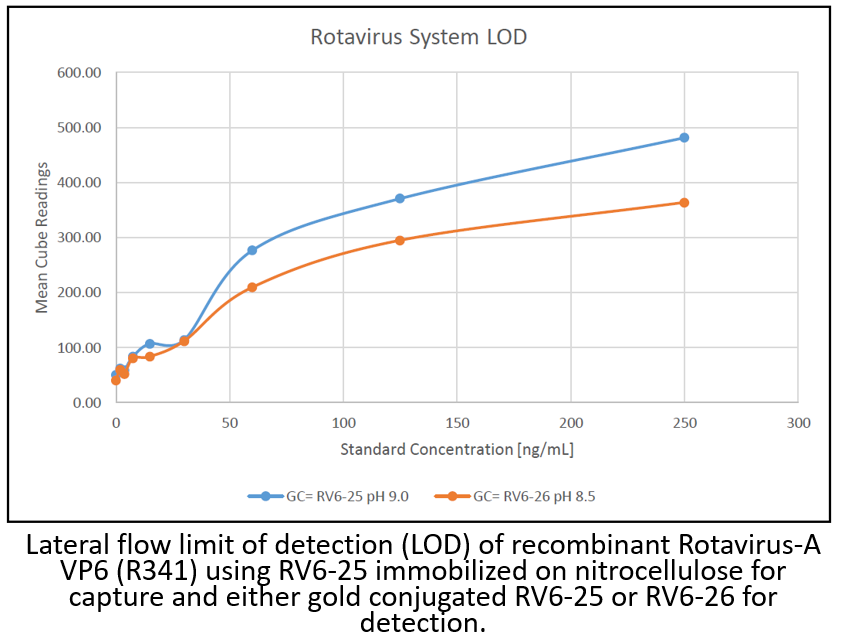Anti-Rotavirus (Clone RV6-26) – Purified No Carrier Protein
Data
- -
- -
Antibody DetailsProduct DetailsReactive Species Rotavirus ⋅ Virus Expression Host HEK-293 Cells Immunogen Human Mab RV6-26 was sequenced from RV-specific B cells isolated from the blood of healthy adult donors or RV-infected infants or adults5,6. Product Concentration ≥1.0 mg/ml Purity ≥90% monomer by analytical SEC and SDS-Page Formulation This recombinant monoclonal antibody is aseptically packaged and formulated in 0.01 M phosphate buffered saline (150 mM NaCl) PBS pH 7.2 - 7.4 with no carrier protein, potassium, calcium or preservatives added. Due to inherent biochemical properties of antibodies, certain products may be prone to precipitation over time. Precipitation may be removed by aseptic centrifugation and/or filtration. Product Preparation Recombinant antibodies are manufactured in an animal free facility using only in vitro protein free cell culture techniques and are purified by a multi-step process including the use of protein A or G to assure extremely low levels of endotoxins, leachable protein A or aggregates. Storage and Handling This antibody may be stored sterile as received at 2-8°C for up to one month. For longer term storage, aseptically aliquot in working volumes without diluting and store at ≤ -70°C. Avoid Repeated Freeze Thaw Cycles. Country of Origin USA Shipping Standard Overnight on Blue Ice. Applications and Recommended Usage? Quality Tested by Leinco Lateral Flow Additional Applications Reported In Literature ? ELISA N FC Each investigator should determine their own optimal working dilution for specific applications. See directions on lot specific datasheets, as information may periodically change. DescriptionDescriptionSpecificity RV6-26 activity is directed against a quaternary epitope on VP6.
This human monoclonal antibody RV6-26 binds at the viral RNA release pore in the DLP5 and is able to neutralize RV by inhibiting transcription7. Structural data suggest steric hindrance inhibits the transcriptional pore7. Background Rotaviruses (RV) are double-stranded, non-enveloped, icosahedral RNA viruses in the Reoviridae family1 that cause severe dehydrating diarrhea in infants and children2. RV particles are composed of concentric viral protein (VP) layers3. The triple-layered particle has an inner capsid layer (VP2), an intermediate capsid layer (VP6), and an outer capsid layer (VP7, VP4). The transcriptionally active double-layered particle (DLP) consists of VP2 and VP6. VP6 is the most antigenic RV protein in humans4.
RV6-26 was generated from RV-specific IgD- B cells isolated from the blood of a healthy immune donor5,6 and exhibits high affinity that is mediated primarily by somatic mutations in the HCDR2 region5. Mutations that alter residues in or near the HCDR2 loop exhibit lower binding affinity than wildtype5. Three-dimensional structural analyses of DLP:Fab complexes show that RV6-26 Fab molecules occupy Type I, II, and III channels5,7. The Fabs are centered inside each of the 132 channels that penetrate the VP6 layer5, bind at both the 5- and 6-fold points of symmetry7, completely block the Type I channel7, but do not make contact with the VP6 subunits surrounding the channels5,7. Two separate regions of the VP6 trimer are recognized within a β-sheet that lies on the exposed side of VP6, part of which is exposed inside the transcriptional pore7. The epitope region requires a quaternary structure that forms a continuous surface of two protomers of the same VP6 trimer7. Matched Pair This antibody has been tested in lateral flow assays. The best matched pair is RV6-25 (Capture)/RV6-26 (Detection). Research Area Infectious Disease . Matched Pair . Rotavirus . Viral . IVD Raw Material References & Citations1. Aiyegbo MS, Eli IM, Spiller BW, et al. J Virol. 88(1):469-76. 2014.
2. Bern C, Martines J, de Zoysa I, et al. Bull World Health Organ. 70: 705-714. 1992. 3. Pesavento, JB, Crawford SE, Estes MK, et al. Curr Top Microbiol Immunol. 309: 189-219. 2006. 4. McKinney BA, Kallewaard NL, Crowe JE, et al. Immunome Res 3:8. 2007. 5. Kallewaard NL, McKinney BA, Gu Y, et al. J Immunol. 180(6):3980-9. 2008. 6. Weitkamp JH, Kallewaard N, Kusuhara K, et al. J Immunol Methods. 275:223–237. 2003. 7. Aiyegbo MS, Sapparapu G, Spiller BW, et al. PLoS ONE. 8(5): e61101. 2013. Technical ProtocolsCertificate of Analysis |
Related Products
- -
- -
Prod No. | Description |
|---|---|
LT582 | |
R341 |



